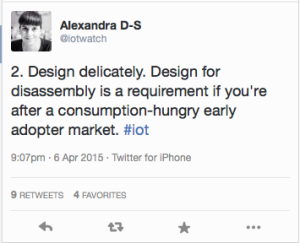Since it’s International IoT Day today, I thought I’d write something about… IoT.
The other day, Alex Deschamps-Sonsino tweeted something that’s been tugging at the corner of my mind since I read it:
As usual, I agree wholeheartedly (with all 5 of her points), but this one resonates for a reason that might or might not be what she intended (haven’t had a chance to discuss it yet): the longevity of connected objects.
Particularly when we’re talking about home appliances and certain kinds of wearables, this is an issue that I’ve not seen many people talking about yet. Look around your house or flat: is everything with an electronic circuit less than 3 years old? If so, you are most definitely in the minority. Cars and coffee makers, vacuum cleaners and radios, lamps and cookers – these are things that are kept for years, even decades – vintage versions are handed down through generations and highly sought after by collectors and lovers of great design. That’s because they’re beautiful, and equally importantly, they (usually) still work.
Contrast this with the world of connected digital (consumer) products. Planned obsolescence is the name of the game here, and the cycles are growing shorter and shorter. Even if you take amazing care of your tablet or smartphone, after a couple of years you can’t upgrade it anymore because the hardware’s too slow, and a couple of years after that your version is no longer supported, so you’re cut off from the latest services. And while an older, hand-me-down laptop might be OK for a light user like a pre-teen son or daughter, it’s not going to cut it for more than 3 years in a work environment. These products are not built to last forever, design icons or no.
This is why I think it’s funny when people try to tell me the Apple Watch is a threat to luxury watchmakers. Patek Philippe’s strapline says, “You never actually own a Patek Philippe. You merely look after it for the next generation.” The Apple Watch is going to compete with that? I think not. It may be well-designed, and it may wrap around your wrist, but it’s a whole different class of object.
I know there are a fair number of people out there trying to work out how to get people to buy a new coffee maker or dishwasher or whatever every two years by embedding connectivity (or not thinking about the implications at all, I’m not sure which is worse). I think it could go the other way as well, making things around the home more functional and pleasant to use and at the same time extending their life span, by applying technology inventively.
For example, most people only use a very few of the myriad programmes available on their washing machines*. That seems reasonable enough, so why is having a gazillion different wash cycle permutations such a key feature? Because different people have different preferences, of course, and the more options there are, the more likely yours is to be covered. But what if part of the process of buying a washing machine were to indicate which of the programmes you wanted to use – then a super-simplified custom front panel could be 3D printed just for you, which you’d then snap onto the front of the machine. If a few years later something changed – you moved in with a partner, or had a kid – you could order a new 3D printed interface, snap the old one off and the new one on. Maybe the manufacturer could spend more money on the core product, making it more sustainable, attractive, long-lasting, if they had the repeat revenue from these upgradeable components.
In a world where we are adding technology as an extra to an already well-understood core feature, maybe instead of applying one world’s ideals to another, running the risk of some kind of Frankenstein experience, we could blend the best aspects of the two and achieve an outcome that is greater than both.
*I learned this from Matt when BERG were working on their Cloudwash project.
